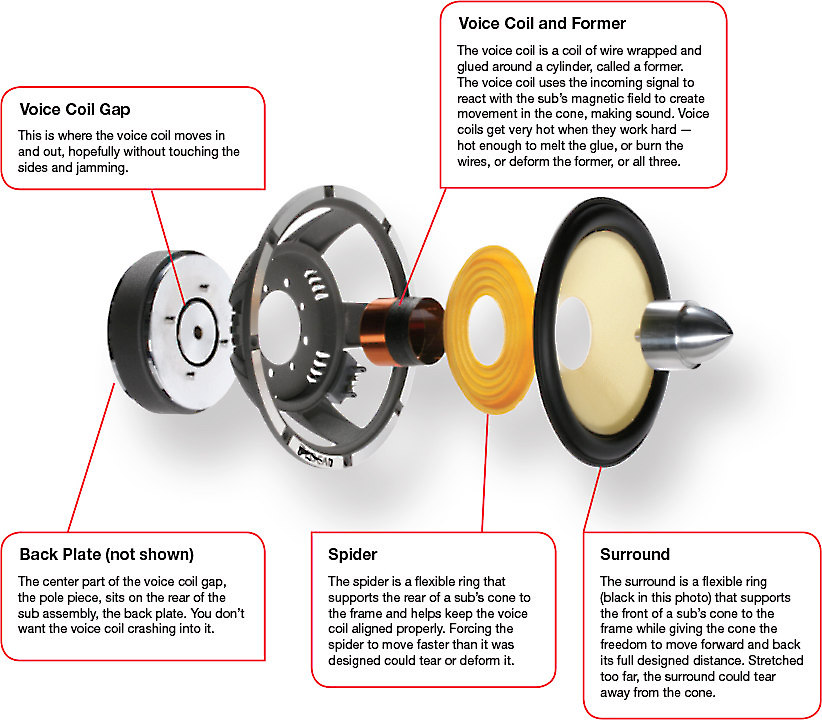To determine if a subwoofer is blown, listen for distortion or a lack of sound. Visually inspect the speaker for damage such as tears or holes in the cone or surround.
If either of these is present, the subwoofer is likely blown. A subwoofer is an essential component of any audio system that enhances the low-frequency sounds of music, movies, and games. However, they can become damaged due to overuse, age, or misuse, resulting in distorted or no sound output.
It is essential to identify if your subwoofer is blown as early as possible to prevent further damage to your audio system. We will explore how to recognize the signs of a blown subwoofer and how to fix or replace this crucial component of your sound system.
Signs Of A Blown Subwoofer
Signs of a Blown Subwoofer:
If you are experiencing distorted sound, it may be an indicator that your subwoofer is blown. This distortion can occur when the speaker cone is not working properly or when the voice coils are damaged.
No sound coming from your subwoofer is also an indication that something is amiss. Inspect your connections and settings to make sure everything is in order before jumping to the conclusion that it is blown.
Rattling or buzzing sounds can be caused by a blown subwoofer as well. This can be caused by a variety of issues such as loose screws, damaged voice coils or a damaged cone.
If you notice an unusual smell coming from your subwoofer, it is a strong indication that it is blown. This can be caused by overheating or burning components within the subwoofer.
It’s always a good idea to inspect your subwoofer on a regular basis so that you can catch any issues early on. If you do suspect that your subwoofer is blown, it may be best to consult with a professional to help diagnose and fix the problem.

Credit: m.youtube.com
How To Check A Subwoofer
To check if a subwoofer is blown, you need to perform a quick sound test. Turn up the volume and listen for any distortion, buzzing, or rattling noises. Additionally, you can check the wiring, cone, and surround for any damage or tears.
Before you decide to replace your subwoofer, it’s important to know whether it’s actually blown or not. There are a few different methods you can use to check.
Visual Inspection
The first thing you can do is visually inspect the subwoofer for any damage. Look for any tears or holes in the cone or surround, or any visible damage to the voice coil. If you see any damage, it’s likely that your subwoofer is blown and needs replacing.
Listening Test
You can also do a listening test by playing some music through the subwoofer and listening for any distortion or rattling sounds. If the subwoofer is producing distorted or rattling sounds, it’s likely that it’s blown and needs to be replaced.
Using a Multimeter
Another method you can use is to test the resistance of the subwoofer’s voice coil using a multimeter. If the resistance is significantly higher or lower than the subwoofer’s specifications, it’s likely that the subwoofer is blown and needs to be replaced.
Fixing A Blown Subwoofer
When it comes to a blown subwoofer, there are a few key signs to look out for. If you notice a decrease in sound quality, distortion, or cracking sounds, these can all be indications that your subwoofer needs repair. Fortunately, there are a few things you can do to fix a blown subwoofer.
Replacing the speaker cone can often be a simple fix. If the cone of your subwoofer is torn or damaged, it will need to be replaced. In addition, replacing the voice coil can also help to repair your subwoofer. The voice coil is the component that generates the magnetic field which moves the speaker cone. Finally, repairing the suspension of the subwoofer can also help to fix the problem. The suspension is responsible for holding the cone in place, and if it is damaged, it can be the cause of the distortion or cracking sounds.
| Decrease in Sound Quality | Distortion | Cracking Sounds |
|---|---|---|
| Sounds less loud. Can cause music to sound flat and lifeless. | Different than distortion from amplifier clipping. Can vary in severity and quality. | Sounds like something is broken. Can be from one or multiple sources. |

Credit: www.reddit.com
Preventing Subwoofer Blowouts
Using the proper amplifier is crucial to prevent subwoofer blowouts. Be sure to match the wattage and impedance of the subwoofer to the amplifier. Choosing a subwoofer with a lower impedance, such as a 2-ohm, can also help prevent blowouts. Proper installation is also key to extending the life of your subwoofer. Make sure it is securely mounted and wired correctly. Additionally, using an equalizer or crossover can help prevent distortion and damage to the subwoofer. Keep an eye on the gain level and adjust it accordingly. Regularly inspect the cone and surround for any signs of wear or damage and replace them if necessary. With proper care and maintenance, you can extend the life of your subwoofer and avoid the headache of a blown speaker.

Credit: www.crutchfield.com
Frequently Asked Questions For How To Tell If Subwoofer Is Blown
How Do I Know If My Subwoofer Is Blown?
To check if your subwoofer is blown, listen for distortion or no sound at all. A blown subwoofer may produce crackling, popping, or a rattling sound even at low volumes. Touching the sub in a non-musical mode can also reveal if there is any noticeable movement or damage to the cone.
Will A Blown Sub Still Make Noise?
Yes, a blown sub can still make noise, but the sound quality may be poor, distorted, or muted compared to a healthy sub. A blown subwoofer cannot properly produce the sound waves that determine a great bass, it may experience uneven vibration or produce rattling or buzzing sound.
How Do I Test My Subwoofer?
To test your subwoofer, play some bass-heavy music and adjust the volume to a moderate level. Walk around the room to ensure the sound is evenly distributed. You can also use a sound meter to measure the sound pressure level.
Lastly, perform a listening test to ensure the subwoofer is producing clear and accurate sound.
How Do You Diagnose A Subwoofer Problem?
To diagnose a subwoofer problem, start by checking the power and signal connections. Test the subwoofer with a different audio source. Listen for any unusual sounds or vibrations. Use an ohmmeter or multimeter to check for continuity in the voice coil.
Finally, check the subwoofer cone for damage.
Conclusion
Finding out if your subwoofer is blown doesn’t have to be a daunting task. By following the tips discussed you can easily detect the issue. It’s important to regularly inspect your equipment and handle them with care to avoid encountering any problems in the future.
Once you’ve detected the issue, don’t hesitate to take action and seek professional assistance to get your subwoofer up and running again. Happy listening!










